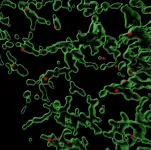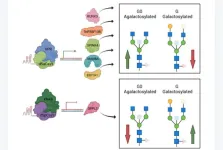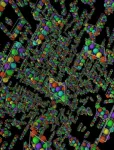(Press-News.org) Waltham — January 3, 2024 — Chronic pain affects approximately 60% of people living with traumatic brain injury (TBI), even up to 30 years after injury, according to new research published in The Journal of Head Trauma Rehabilitation (JHTR), the official journal of the Brain Injury Association of America. The journal is published in the Lippincott portfolio by Wolters Kluwer.
"This is the first study to examine the experience of chronic pain in a large TBI sample this far post-injury," explain Cynthia Harrison-Felix, PhD, FACRM, Co-Project Director of the TBI Model System at Craig Hospital in Englewood, CO, and colleagues. "Pain status did not differ significantly across follow-up years. While our data are not longitudinal, it suggests that chronic pain occurs at varying points after injury, and may interfere with initial recovery and long-term, necessitating proactive pain assessment and treatment."
Leveraging a large research network uncovers a high incidence of chronic pain after TBI
The researchers surveyed patients who were being followed in the TBI Model Systems, a research program that includes the 18 U.S. rehabilitation centers in the study. All 3804 respondents had been hospitalized with moderate to severe TBI. Most were white (77%) and male (75%), and average time since injury was five years (range, 1–30 years).
The survey informed participants that chronic pain can be defined as "persistent or recurring pain that lasts longer than three months. It includes headaches or pain anywhere in the body, which occurs more than half of the days over a three-month period." When the study participants were asked specifics about their own pain, the key results were:
46% reported current chronic pain, 14% reported past chronic pain (after TBI), and 40% reported no chronic pain
32.5% of participants with current chronic pain reported constant pain
Compared with participants who reported no chronic pain after TBI or only past chronic pain, those with current chronic pain had significantly worse results on all three outcome measures included in the survey: the Functional Independence Measure motor and cognitive subscores, the Disability Rating Scale, and the Glasgow Outcome Scale–Extended
Medications are the most frequently used treatments
Medications, physical therapy, and home exercise programs were the pain treatments most commonly reported. Medications were used by 91% of participants with current chronic pain and had been used by 90% of those with past chronic pain.
The least frequently reported treatment was comprehensive chronic pain rehabilitation. This finding "suggests there may be an access issue given the proven benefit," Dr. Harrison-Felix’s group notes. Pain treatments known to be effective in other patient populations, such as psychotherapy and biofeedback, were not often reported.
"Chronic pain should be assessed and treated along with other neurocognitive and neurobehavioral disorders such as memory deficits and depression," the researchers conclude. "While we cannot assess the directionality of the relationship between pain and outcomes, the findings indicate that the presence of chronic pain after TBI is far from benign."
Read Article [ Characterization and Treatment of Chronic Pain After Traumatic Brain Injury—Comparison of Characteristics Between Individuals With Current Pain, Past Pain, and No Pain: A NIDILRR and VA TBI Model Systems Collaborative Project ]
Wolters Kluwer provides trusted clinical technology and evidence-based solutions that engage clinicians, patients, researchers and students in effective decision-making and outcomes across healthcare. We support clinical effectiveness, learning and research, clinical surveillance and compliance, as well as data solutions. For more information about our solutions, visit https://www.wolterskluwer.com/en/health.
###
About The Journal of Head Trauma Rehabilitation
The Journal of Head Trauma Rehabilitation (JHTR) is a leading, international, peer-reviewed resource that provides up-to-date information on the treatment of individuals and families affected by traumatic brain injury (TBI), the systems of care in which services are provided, and epidemiologic and public health issues relevant to TBI. Six issues each year aspire to the vision of "knowledge informing care" and include a wide range of articles, topical issues, commentaries, and special features. JHTR is the official journal of the Brain Injury Association of America (BIAA).
About the Brain Injury Association of America
The Brain Injury Association of America (BIAA) strives to be a primary authority on medical diagnosis and treatment, disease management, research, and life challenges associated with brain injury and a leading influencer of public awareness and public policy change. It encourages individuals with brain injury and their family members to participate in meaningful ways while welcoming the involvement of researchers, clinicians, and other professionals.
About Wolters Kluwer
Wolters Kluwer (EURONEXT: WKL) is a global leader in information, software, and services for professionals in healthcare, tax and accounting, financial and corporate compliance, legal and regulatory, and corporate performance and ESG. We help our customers make critical decisions every day by providing expert solutions that combine deep domain knowledge with specialized technology and services.
Wolters Kluwer reported 2022 annual revenues of €5.5 billion. The group serves customers in over 180 countries, maintains operations in over 40 countries, and employs approximately 20,900 people worldwide. The company is headquartered in Alphen aan den Rijn, the Netherlands.
For more information, visit www.wolterskluwer.com, follow us on LinkedIn, Facebook, and YouTube.
END
Pain is a major problem for individuals with traumatic brain injury
Nearly half of adults with TBI who received inpatient rehabilitation reported current chronic pain, and an additional 14% reported past chronic pain since their injury
2024-01-03
ELSE PRESS RELEASES FROM THIS DATE:
Research reveals promising approach to enhance treatment for sleep apnea-related issues
2024-01-03
A groundbreaking study published in the American Journal of Respiratory and Critical Care Medicine provides new insights into the treatment of obstructive sleep apnea (OSA) and its associated health impacts.
Researchers at the University of Missouri School of Medicine and the Marshall University Joan C. Edwards School of Medicine led by David Gozal, M.D., M.B.A., Ph.D. (Hon), vice president of health affairs at Marshall University and dean of the Joan C. Edwards School of Medicine, explored innovative therapeutic strategies that could greatly advance the understanding and management of OSA-related ...
Seismic and infrasonic signals used to characterize Nord Stream pipeline events
2024-01-03
Seismic events that coincided with sudden drops in pressure within the Nord Stream 1 and 2 natural gas pipelines in September 2022 alerted the world to the rupture of pipelines in the western Baltic Sea. The suspected act of sabotage, which reportedly used explosive charges to rupture the pipelines, is still under investigation by multiple countries.
A new study published in The Seismic Record provides further evidence that the Nord Stream seismic signals came from a complex source. The signals lasted longer than would be expected from a single explosive source, the ...
Surprise! – How the brain learns to deal with the unexpected
2024-01-03
For children, the world is full of surprises. Adults, on the other hand, are much more difficult to surprise. And there are complex processes behind this apparently straightforward state of affairs. Researchers at the University of Basel have been using mice to decode how reactions to the unexpected develop in the growing brain.
Babies love playing peekaboo, continuing to react even on the tenth sudden appearance of their partner in the game. Recognizing the unexpected is an important cognitive ability. After all, new can also mean dangerous.
The exact way in which surprises are processed in the brain changes as we grow, however: unusual ...
Genetic variants underlying male bisexual behavior, risk-taking linked to more children, study shows
2024-01-03
ANN ARBOR—Because same-sex sexual behavior does not result in offspring, evolutionary biologists have long wondered how the genes associated with this behavior have persisted in the human genome, and whether they will remain in the future.
A new University of Michigan-led study, scheduled for publication Jan. 3 in the journal Science Advances, suggests that part of the explanation—specifically for male bisexuals—has to do with risk-taking behavior.
The U-M researchers analyzed data from more than 450,000 participants of European ancestry in the United Kingdom's Biobank database of genetic and health information. Participants responded to a questionnaire ...
Shining a light on the hidden damage of mild brain injuries
2024-01-03
Researchers have created a new brain imaging method that allows mild traumatic brain injuries (mTBIs) to be diagnosed, even when existing imaging techniques like magnetic resonance imaging (MRI) don’t show any structural abnormalities. The technique involves loading gadolinium, a standard MRI contrast agent, into hydrogel-based micropatches that are attached to immune cells called macrophages. mTBIs cause inflammation in the brain, which produces signals that attract macrophages to migrate there. Coupling the gadolinium contrast agent to these cells enables MRI to reveal ...
Weill Cornell Medicine receives grant for blood test to diagnose breast cancer
2024-01-03
Weill Cornell Medicine researchers received a $2.4 million grant from the U.S. Department of Defense Breast Cancer Research Program to validate a new blood test for the early detection of breast cancer.
Researchers are evaluating Syantra DX Breast Cancer (Syantra Inc.), an experimental diagnostic test that detects specific biomarkers in blood associated with breast cancer. The test uses an artificial intelligence algorithm to determine whether a patient is positive for cancer as soon as detectable by mammogram or possibly earlier, and before symptoms arise.
“This new liquid biopsy, ...
Using the body’s own cells to treat traumatic brain injury
2024-01-03
Scientists have created a new treatment for traumatic brain injury (TBI) that shrank brain lesions by 56% and significantly reduced local inflammation levels in pigs. The new approach leverages macrophages, a type of white blood cell that can dial inflammation up or down in the body in response to infection and injury. The team created disc-shaped microparticles called “backpacks” containing anti-inflammatory molecules, then attached them directly to the macrophages. These molecules kept the cells in an anti-inflammatory state ...
UW–Madison scientists reveal the inner workings of an essential protein trafficking complex
2024-01-03
MADISON – Like mail carriers who manage to deliver their parcels through snow, rain, heat and gloom, a critical group of mammalian proteins helps cells function properly even under less-than-ideal conditions.
Using state-of-the-art cell imaging and genome editing technology, University of Wisconsin–Madison scientists have begun to unravel how this collection of proteins performs its essential service. The discovery could eventually help researchers better understand and develop new treatments for diseases like cancer, diabetes and those that cause immune dysfunction.
Led by Anjon Audhya, a professor in the Department of Biomolecular Chemistry, the research team sought ...
Mapping of the gene network that regulates glycan clock of ageing
2024-01-03
“[...] we were able to confirm the functional role of three genes (MANBA, TNFRSF13B and EEF1A1) in the IgG galactosylation pathway [...]”
BUFFALO, NY- January 3, 2024 – A new research paper was published in Aging (listed by MEDLINE/PubMed as "Aging (Albany NY)" and "Aging-US" by Web of Science) Volume 15, Issue 24, entitled, “Mapping of the gene network that regulates glycan clock of ageing.”
Glycans are an essential structural component of immunoglobulin G (IgG) that modulate its structure and function. However, regulatory mechanisms behind this complex posttranslational ...
Computational method discovers hundreds of new ceramics for extreme environments
2024-01-03
DURHAM, N.C. – If you have a deep-seated, nagging worry over dropping your phone in molten lava, you’re in luck.
A research team led by materials scientists at Duke University has developed a method for rapidly discovering a new class of materials with heat and electronic tolerances so rugged that they that could enable devices to function at lava-like temperatures above several thousands of degrees Fahrenheit.
Harder than steel and stable in chemically corrosive environments, these materials ...
LAST 30 PRESS RELEASES:
Orthopedics can play critical role in identifying intimate partner violence
Worms as particle sweepers
Second spider-parasitic mite described in Brazil
January 2026 issues of APA journals feature new research on autism, pediatric anxiety, psychedelic therapy, suicide prevention and more
Private equity acquired more than 500 autism centers over the past decade, new study shows
New cervical cancer screening guidelines from the US Department of Health and Human Services
Estimated burden of COVID-19 illnesses, medical visits, hospitalizations, and deaths in the US from October 2022 to September 2024
Smartphone use during school hours by US youth
Food insecurity and adverse social conditions tied to increased risk of long COVID in children
Earliest, hottest galaxy cluster gas on record could change our cosmological models
Greenland’s Prudhoe Dome ice cap was completely gone only 7,000 years ago, first GreenDrill study finds
Scientific validity of blue zones longevity research confirmed
Injectable breast ‘implant’ offers alternative to traditional surgeries
Neuroscientists devise formulas to measure multilingualism
New prostate cancer trial seeks to reduce toxicity without sacrificing efficacy
Geometry shapes life
A CRISPR screen reveals many previously unrecognized genes required for brain development and a new neurodevelopmental disorder
Hot flush treatment has anti-breast cancer activity, study finds
Securing AI systems against growing cybersecurity threats
Longest observation of an active solar region
Why nail-biting, procrastination and other self-sabotaging behaviors are rooted in survival instincts
Regional variations in mechanical properties of porcine leptomeninges
Artificial empathy in therapy and healthcare: advancements in interpersonal interaction technologies
Why some brains switch gears more efficiently than others
UVA’s Jundong Li wins ICDM’S 2025 Tao Li Award for data mining, machine learning
UVA’s low-power, high-performance computer power player Mircea Stan earns National Academy of Inventors fellowship
Not playing by the rules: USU researcher explores filamentous algae dynamics in rivers
Do our body clocks influence our risk of dementia?
Anthropologists offer new evidence of bipedalism in long-debated fossil discovery
Safer receipt paper from wood
[Press-News.org] Pain is a major problem for individuals with traumatic brain injuryNearly half of adults with TBI who received inpatient rehabilitation reported current chronic pain, and an additional 14% reported past chronic pain since their injury


